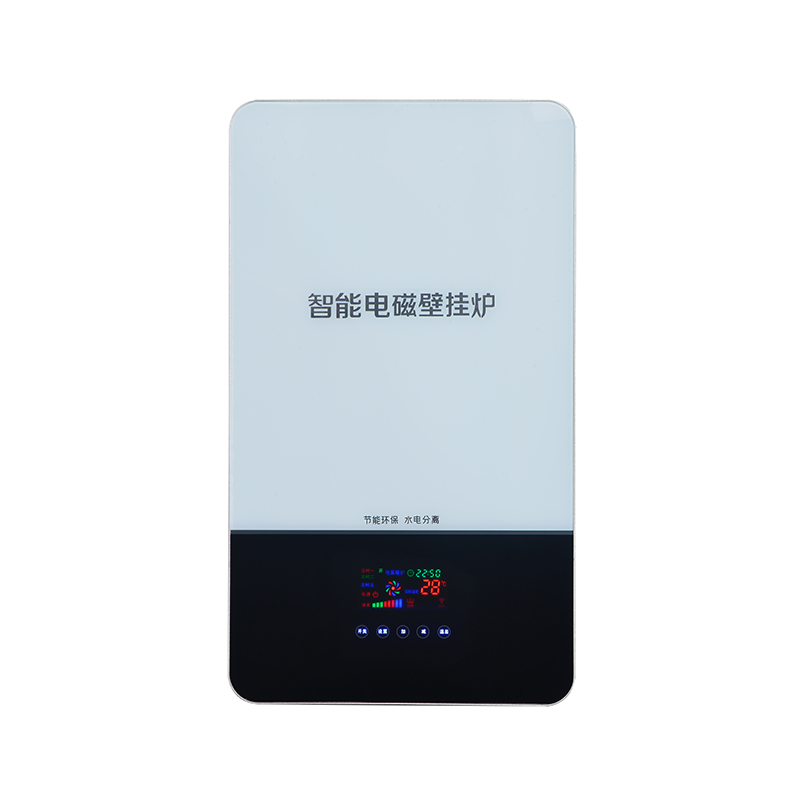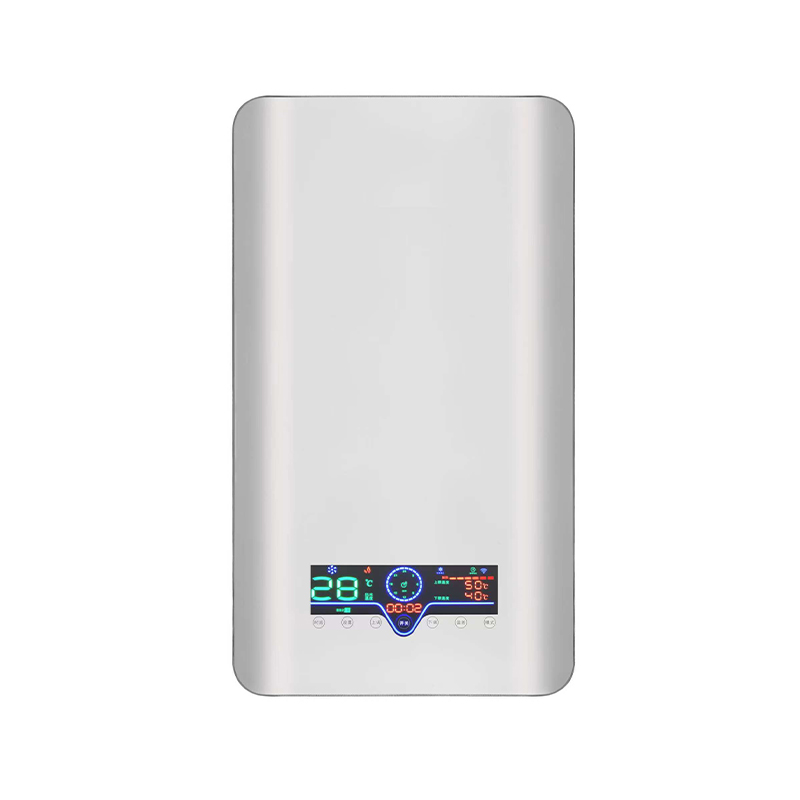How does the electromagnetic heating furnace achieve efficient heat conversion?
Release Time : 2025-06-26
With the advancement of technology, the electromagnetic heating furnace has gradually become an ideal choice for household hot water supply. Compared with traditional gas or resistance heating equipment, it not only performs well in energy saving and environmental protection, but also has significant advantages in heat conversion efficiency.
1. Material selection and design optimization
The electromagnetic heating furnace furnace has been carefully optimized in material selection and structural design to ensure the highest heat transfer efficiency. First, materials with high thermal conductivity such as stainless steel or copper-nickel alloy are used as the main material of the heating element. These materials not only have excellent corrosion resistance, but also can quickly and evenly transfer heat and reduce energy loss. In addition, the design of the heating element also minimizes thermal resistance, allowing heat to be quickly transferred to the water, thereby improving the overall thermal efficiency.
At the same time, the water flow path inside the wall-mounted boiler has also been carefully planned to avoid unnecessary bends and dead ends, ensure smooth water flow, and maximize the use of every inch of the heating surface. This optimized design not only improves the heat exchange efficiency, but also extends the service life of the equipment and reduces maintenance costs.
2. The role of intelligent control system
The electromagnetic heating furnace is equipped with an advanced control system that can monitor and adjust various parameters during the heating process in real time. Through built-in sensors, the system can accurately measure water temperature, flow rate and ambient temperature, and automatically adjust power output based on these data to achieve the best heating effect. For example, in the cold winter period, when the inlet water temperature is detected to be low, the system will automatically increase power output; in the spring and autumn seasons, when demand is low, it will reduce energy consumption accordingly.
In addition, the intelligent control system also has a learning function that can make predictive adjustments based on user usage habits and historical data. For example, if the system finds that the user usually starts taking a bath around 7 pm, it will preheat in advance at the appropriate time to ensure that the user can enjoy comfortable hot water immediately after returning home without having to wait for a long time.
3. Accurate temperature control
Temperature control is one of the key factors affecting the efficiency of thermal energy conversion. Traditional heating equipment often has problems such as large temperature fluctuations and slow response speed, resulting in energy waste. The electromagnetic heating furnace achieves extremely accurate temperature control through the PID (proportional-integral-differential) control algorithm. The algorithm can dynamically adjust the heating power so that the water temperature always fluctuates within a very narrow range, thus avoiding energy loss caused by frequent start and stop.
In addition, some high-end products are also equipped with frequency conversion technology, which can flexibly adjust the heating frequency according to actual needs. This not only further improves the thermal efficiency, but also effectively reduces noise, providing a quieter and more comfortable use experience.
4. Safety and energy-saving advantages of water-electricity separation design
The electromagnetic heating furnace adopts a water-electricity separation design, that is, the heating element is completely isolated from the water, and heat is only generated by magnetic field induction. This design not only greatly improves safety and prevents the risk of leakage, but also reduces energy loss caused by direct contact. Since there is no physical contact during electromagnetic induction heating, there are no problems such as oxidation and corrosion that are common in traditional resistance heating, ensuring long-term stable operation.
In addition, the water-electricity separation design also means that the heating element can work at a higher temperature without being affected by water quality, thereby improving the overall heating efficiency. At the same time, this design also helps to reduce scale formation, because there will be no local high temperature areas during the heating process, reducing the possibility of mineral deposition.
5. Remote monitoring and intelligent interconnection
Modern electromagnetic heating furnaces usually support remote monitoring and intelligent interconnection functions. Users can check the status of the device and operate it anytime and anywhere through mobile phone applications. For example, when you are on the way out, you can start the heating program in advance to ensure that you can enjoy a warm indoor environment or a comfortable hot bath as soon as you get home. This intelligent management method not only improves the convenience of life, but also provides strong support for energy conservation and emission reduction.
With the help of Internet of Things technology, the device can also be linked with other smart home systems to form a complete ecosystem. For example, when you turn on the air conditioner in the living room, the wall-mounted boiler can automatically adjust the power output according to the changes in indoor and outdoor temperatures, maintain a constant indoor temperature, and avoid unnecessary energy consumption.
6. Energy-saving mode and environmental considerations
In order to further improve the energy efficiency ratio, many electromagnetic heating furnaces are equipped with a special energy-saving mode. In this mode, the system will dynamically adjust the power output according to actual needs to minimize energy waste. For example, at night or when no one is around, the device will automatically enter a low-power state, but it can still maintain basic warming functions and quickly resume normal work when someone is active.
In addition, considering environmental protection requirements, some brands have also introduced renewable energy compatibility design in the product development stage, allowing users to access solar energy or other clean energy systems to further reduce carbon emissions. This forward-looking design concept not only conforms to the current global green development trend, but also provides consumers with more sustainable choices.
In summary, the electromagnetic heating furnace achieves efficient heat energy conversion through a number of advanced technical means such as material optimization, intelligent control, precise temperature management, water-electricity separation design, and remote monitoring. It not only brings users a comfortable and convenient life experience, but also makes important contributions to energy conservation and environmental protection.
1. Material selection and design optimization
The electromagnetic heating furnace furnace has been carefully optimized in material selection and structural design to ensure the highest heat transfer efficiency. First, materials with high thermal conductivity such as stainless steel or copper-nickel alloy are used as the main material of the heating element. These materials not only have excellent corrosion resistance, but also can quickly and evenly transfer heat and reduce energy loss. In addition, the design of the heating element also minimizes thermal resistance, allowing heat to be quickly transferred to the water, thereby improving the overall thermal efficiency.
At the same time, the water flow path inside the wall-mounted boiler has also been carefully planned to avoid unnecessary bends and dead ends, ensure smooth water flow, and maximize the use of every inch of the heating surface. This optimized design not only improves the heat exchange efficiency, but also extends the service life of the equipment and reduces maintenance costs.
2. The role of intelligent control system
The electromagnetic heating furnace is equipped with an advanced control system that can monitor and adjust various parameters during the heating process in real time. Through built-in sensors, the system can accurately measure water temperature, flow rate and ambient temperature, and automatically adjust power output based on these data to achieve the best heating effect. For example, in the cold winter period, when the inlet water temperature is detected to be low, the system will automatically increase power output; in the spring and autumn seasons, when demand is low, it will reduce energy consumption accordingly.
In addition, the intelligent control system also has a learning function that can make predictive adjustments based on user usage habits and historical data. For example, if the system finds that the user usually starts taking a bath around 7 pm, it will preheat in advance at the appropriate time to ensure that the user can enjoy comfortable hot water immediately after returning home without having to wait for a long time.
3. Accurate temperature control
Temperature control is one of the key factors affecting the efficiency of thermal energy conversion. Traditional heating equipment often has problems such as large temperature fluctuations and slow response speed, resulting in energy waste. The electromagnetic heating furnace achieves extremely accurate temperature control through the PID (proportional-integral-differential) control algorithm. The algorithm can dynamically adjust the heating power so that the water temperature always fluctuates within a very narrow range, thus avoiding energy loss caused by frequent start and stop.
In addition, some high-end products are also equipped with frequency conversion technology, which can flexibly adjust the heating frequency according to actual needs. This not only further improves the thermal efficiency, but also effectively reduces noise, providing a quieter and more comfortable use experience.
4. Safety and energy-saving advantages of water-electricity separation design
The electromagnetic heating furnace adopts a water-electricity separation design, that is, the heating element is completely isolated from the water, and heat is only generated by magnetic field induction. This design not only greatly improves safety and prevents the risk of leakage, but also reduces energy loss caused by direct contact. Since there is no physical contact during electromagnetic induction heating, there are no problems such as oxidation and corrosion that are common in traditional resistance heating, ensuring long-term stable operation.
In addition, the water-electricity separation design also means that the heating element can work at a higher temperature without being affected by water quality, thereby improving the overall heating efficiency. At the same time, this design also helps to reduce scale formation, because there will be no local high temperature areas during the heating process, reducing the possibility of mineral deposition.
5. Remote monitoring and intelligent interconnection
Modern electromagnetic heating furnaces usually support remote monitoring and intelligent interconnection functions. Users can check the status of the device and operate it anytime and anywhere through mobile phone applications. For example, when you are on the way out, you can start the heating program in advance to ensure that you can enjoy a warm indoor environment or a comfortable hot bath as soon as you get home. This intelligent management method not only improves the convenience of life, but also provides strong support for energy conservation and emission reduction.
With the help of Internet of Things technology, the device can also be linked with other smart home systems to form a complete ecosystem. For example, when you turn on the air conditioner in the living room, the wall-mounted boiler can automatically adjust the power output according to the changes in indoor and outdoor temperatures, maintain a constant indoor temperature, and avoid unnecessary energy consumption.
6. Energy-saving mode and environmental considerations
In order to further improve the energy efficiency ratio, many electromagnetic heating furnaces are equipped with a special energy-saving mode. In this mode, the system will dynamically adjust the power output according to actual needs to minimize energy waste. For example, at night or when no one is around, the device will automatically enter a low-power state, but it can still maintain basic warming functions and quickly resume normal work when someone is active.
In addition, considering environmental protection requirements, some brands have also introduced renewable energy compatibility design in the product development stage, allowing users to access solar energy or other clean energy systems to further reduce carbon emissions. This forward-looking design concept not only conforms to the current global green development trend, but also provides consumers with more sustainable choices.
In summary, the electromagnetic heating furnace achieves efficient heat energy conversion through a number of advanced technical means such as material optimization, intelligent control, precise temperature management, water-electricity separation design, and remote monitoring. It not only brings users a comfortable and convenient life experience, but also makes important contributions to energy conservation and environmental protection.





